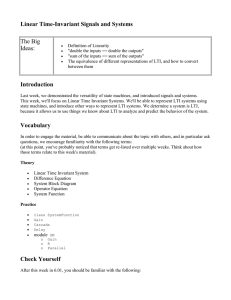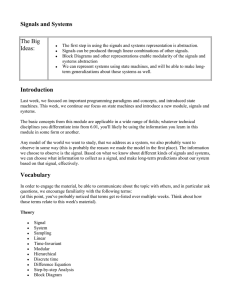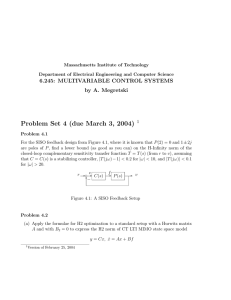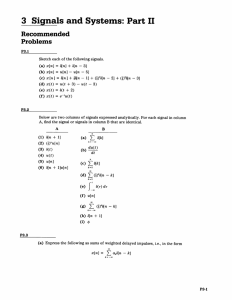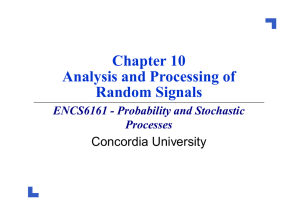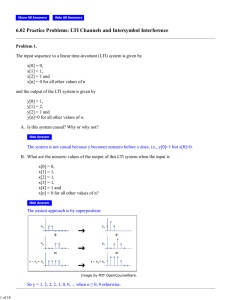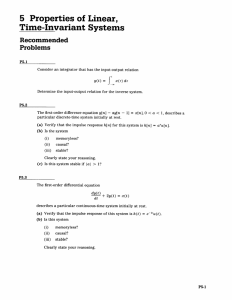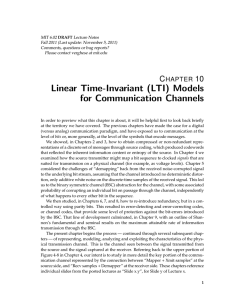6.02 Practice Problems: LTI Channels and Intersymbol Interference
advertisement
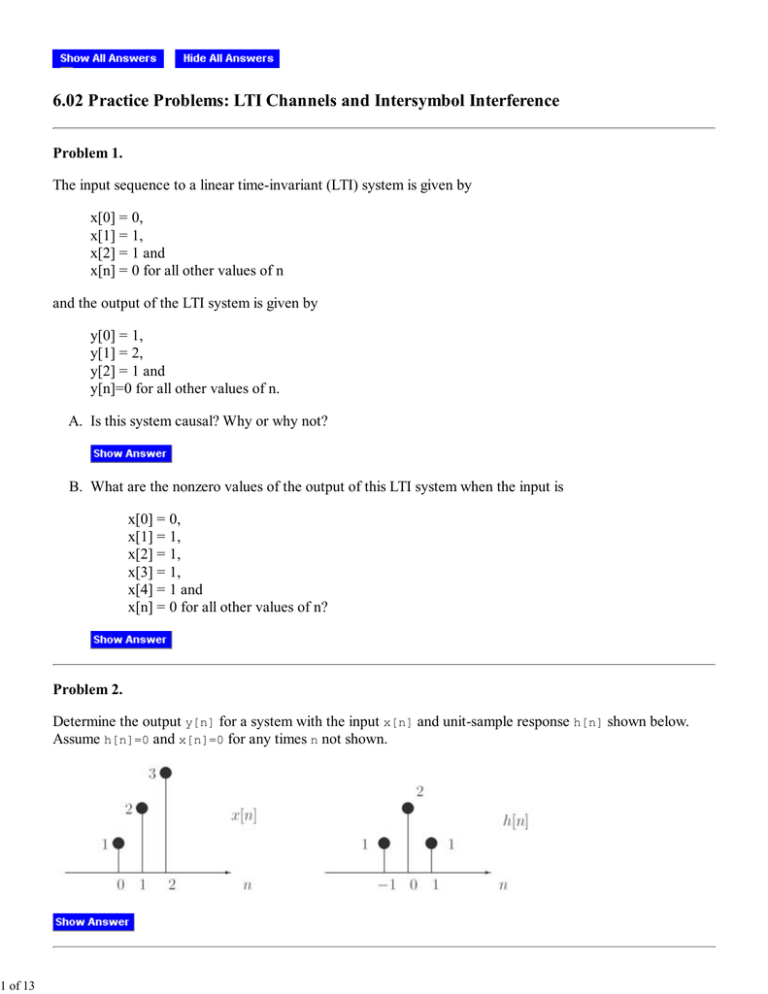
6.02 Practice Problems: LTI Channels and Intersymbol Interference
Problem 1.
The input sequence to a linear time-invariant (LTI) system is given by
x[0] = 0,
x[1] = 1,
x[2] = 1 and
x[n] = 0 for all other values of n
and the output of the LTI system is given by
y[0] = 1,
y[1] = 2,
y[2] = 1 and
y[n]=0 for all other values of n.
A. Is this system causal? Why or why not?
B. What are the nonzero values of the output of this LTI system when the input is
x[0] = 0,
x[1] = 1,
x[2] = 1,
x[3] = 1,
x[4] = 1 and
x[n] = 0 for all other values of n?
Problem 2.
Determine the output y[n] for a system with the input x[n] and unit-sample response h[n] shown below.
Assume h[n]=0 and x[n]=0 for any times n not shown.
1 of 13
Problem 3. A discrete-time linear system produces output v when the input is the unit step u. What is the
output h when the input is the unit-sample δ? Assume v[n]=0 for any times n not shown below.
Problem 4.
The output of a particular communication channel is given by
y[n] = αx[n] + βx[n-1] where α > β
1. Is the channel linear? Is it time invariant?
2. What is the channel's unit-sample response h?
3. If the input is the following sequence of samples starting at time 0:
x[n] = [1, 0, 0, 1, 1, 0, 1, 1], followed by all 1's.
then what is the channel's output assuming α=.7 and β=.3?
4. Again let α=.7 and β=.3. Derive a deconvolver for this channel and compute the input sequence that
produced the following output:
y[n] = [.7, 1, 1, .3, .7, 1, .3, 0], followed by all 0's.
Problem 5.
Suppose four different channels {I,II,III,IIII} have four different unit sample responses:
h1 = .25, .25, .25, .25, 0, ...
2 of 13
h2 = 0, .25, .5, .25, 0, ...
h3 = .11, .22, .33, .22, .11, 0, ...
3 of 13
h4 = .04, .08, .12, .16, .20, .12, .12, .12, .04, 0, ...
Each of the following eye diagrams is associated with transmitting bits using one of the four channels, where
five samples were used per bit. That is, a one bit is five one-volt samples and a zero bit is five zero-volt
samples. Please determine which channel was used in each case.
4 of 13
5 of 13
Problem 6.
This question refers to the LTI systems, I, II and III, whose unit-sample responses are shown below:
6 of 13
In this question, the input to these systems are bit streams with eight voltage samples per bit, with eight
one-volt samples representing a one bit and eight zero-volt samples representing a zero bit.
A. Which system (I, II or III) generated the following eye diagram? To ensure at least partial credit for
your answer, explain what led you to rule out the systems you did not select.
7 of 13
Problem 7.
Suppose a linear time-variant channel has a unit sample response given by
h[n] = 1/2
h[n] = 0
n = 0, 1, 2
otherwise
If the input to the channel is
x[n] = 3/2
x[n] = 0
n = 2, 3, 4
otherwise
please determine the maximum value of the output of the channel and the index at which that maximum
occurs.
Problem 8.
For this problem, please consider three linear and time-invariant channels, channel one, channel two, and
channel three. The unit sample response for each of these three channels are plotted below. Please use these
plots to answer all the parts of this question.
A. Which channel (1, 2, or 3) has the following step response, and what is the value of maximum value of
the step response?
8 of 13
l
B. Which channel (1, 2, or 3) produced the pair of transmitted and received samples in the graph below,
and what is the value of voltage sample number 24 (assuming the transmitted samples have the value of
either one volt or zero volts)?
9 of 13
Problem 9.
In this problem you will be answering questions about a causal linear time-invariant channel characterized by
its response to a five-sample pulse, denoted p5[n].
A. Suppose the input to the channel is as plotted below. Plot the output of the channel on the axes
provided beneath the input.
10 of 13
B. The unit sample response, h[n], can be related to the step response, s[n] by the formula h[n] = s[n]
- s[n-1]. Please derive a similar formula for h[n] in terms of the five-sample pulse response p5[n]
(an infinite series is an acceptable form for the answer).
Problem 10.
For all parts of this problem, please consider five linear and time-invariant channels, cleverly titled channel I,
channelII, channel III, channel IV and channel V. The unit sample response for each of these five channels is
plotted below, with the values outside the interval 0 to 14 being zero. Please use these plots to answer all the
parts of this problem.
Please note:
All the voltage values in the five plots are integer multiples of 0.1 volt.
A particular channel can be the answer to more than one part.
11 of 13
A. Plot the unit step response s[n] for Channel I for 0 ≤ n ≤ 14.
B. Which two channels have step responses, s[n], that approach the same value as n → ∞ and what is that
value?
C. Suppose the input to each of the channels is x[n] = 1 for 0 ≤ n ≤ 9 and zero otherwise. Which
channel has the output y[n] plotted below, and what is value of the n = 15 output sample (not
plotted)?
12 of 13
13 of 13
MIT OpenCourseWare
http://ocw.mit.edu
6.02 Introduction to EECS II: Digital Communication Systems
Fall 2012
For information about citing these materials or our Terms of Use, visit: http://ocw.mit.edu/terms.
